
This is a list of Buddhist temples, monasteries, stupas, and pagodas in Mongolia for which there are Wikipedia articles, sorted by location.

This is a list of Buddhist temples, monasteries, stupas, and pagodas in Mongolia for which there are Wikipedia articles, sorted by location.
Articles related to Mongolia include:
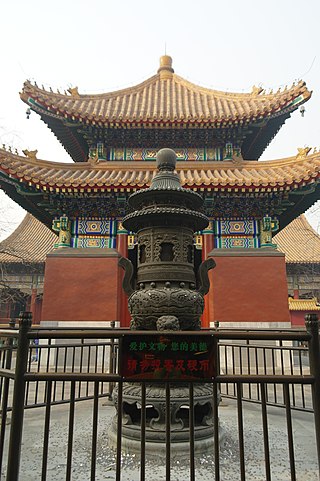
The Yonghe Temple, also known as the Yonghe Lamasery, or popularly as the Lama Temple, is a temple and monastery of the Gelug school of Tibetan Buddhism located on 12 Yonghegong Street, Dongcheng District, Beijing, China. The building and artwork of the temple is a combination of Han Chinese and Tibetan styles. This building is one of the largest Tibetan Buddhist monasteries in China proper. The current abbot is Lama Hu Xuefeng.
Shankh Monastery located in Övörkhangai Province, Central Mongolia, 25 kilometers South East of Kharkhorin city, is one of Mongolia’s oldest and most historically significant monasteries. It was founded in 1647 by Zanabazar, the first Jebtsundamba Khutuktu, or spiritual head of Tibetan Buddhism for the Khalkha in Outer Mongolia, around the same time as the establishment of the nearby Tövkhön Monastery.
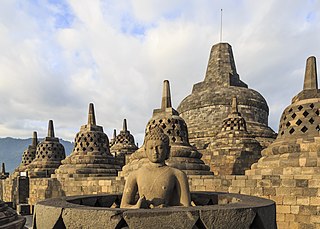
Buddhist religious architecture developed in the Indian subcontinent. Three types of structures are associated with the religious architecture of early Buddhism: monasteries (viharas), places to venerate relics (stupas), and shrines or prayer halls, which later came to be called temples in some places.

Namgyal Monastery is currently located in Mcleod Ganj, Dharamsala, India. It is the personal monastery of the 14th Dalai Lama. Another name for this temple-complex is Namgyal Tantric College.

Buddhism is the largest religion in Mongolia practiced by 51.7% of Mongolia's population, according to the 2020 Mongolia census. Buddhism in Mongolia derives much of its recent characteristics from Tibetan Buddhism of the Gelug and Kagyu lineages, but is distinct and presents its own unique characteristics.
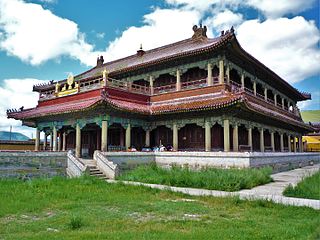
Amarbayasgalant Monastery or the "Monastery of Tranquil Felicity", is one of the three largest Buddhist monastic centers in Mongolia. The monastery complex is located in the Iven Valley near the Selenge River, at the foot of Mount Büren-Khaan in Baruunbüren sum (district) of Selenge Province in northern Mongolia. The nearest town is Erdenet which is about 60 km to the southwest.

Öndör Gegeen Zanabazar was the first Jebtsundamba Khutuktu and the first Bogd Gegeen or supreme spiritual authority, of the Gelugpa lineage of Tibetan Buddhism in Mongolia.
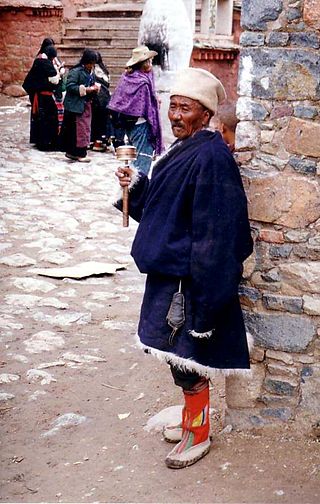
The most important places in Buddhism are located in the Indo-Gangetic Plain of northern India and southern Nepal, in the area between New Delhi and Rajgir. This is the area where Gautama Buddha lived and taught, and the main sites connected to his life are now important places of pilgrimage for both Buddhists and Hindus. Many countries that are or were predominantly Buddhist have shrines and places which can be visited as a pilgrimage.

Gandantegchinlen Monastery, also known as Gandan Monastery, is a Buddhist monastery in Ulaanbaatar, Mongolia. It was founded in 1809, closed amid persecutions in 1939, and from 1944 to 1989 was the country's only active monastery. Today, it is the center of Buddhism in Mongolia. The monastery has more than 100 resident monks and numerous Buddhist treasures, including a 26-metre (85 ft) statue of Avalokiteśvara made of gilded bronze and precious stones.
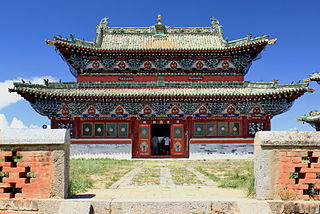
The Erdene Zuu Monastery is probably the earliest surviving Buddhist monastery in Mongolia. Located in Övörkhangai Province, approximately 2 km north-east from the center of Kharkhorin and adjacent to the ancient city of Karakorum, it is part of the Orkhon Valley Cultural Landscape World Heritage Site. The monastery is affiliated with the Gelug sect of Tibetan Buddhism.

Erdenedalai is a sum (district) and town of Dundgovi Province in central Mongolia. Erdenedalai sum is the second most populous sum of Dundgovi Province after Saintsagaan.

The architecture of Mongolia is largely based on traditional dwellings, such as the yurt and the tent. During the 16th and 17th centuries, lamaseries were built throughout the country as temples which were later enlarged to accommodate a growing number of worshipers. Mongolian architects designed their temples with six and twelve angles and pyramidal roofs approximating the yurt's round shape. Further expansion led to a quadratic shape in the design of the temples, with roofs in the shape of pole marquees. Trellis walls, roof poles and layers of felt were eventually replaced by stone, brick beams and planks.
The World Buddhist Scout Council (WSBC) formerly the World Buddhist Scout Brotherhood until 2009 is an autonomous, international body committed to promoting and supporting Buddhism within Scouting. The WBSB began as a means to facilitate religious activities among Buddhist Scouts. The WBSC was declared active with the election of its chairman on July 21, 2004, and received consultative status with the World Scout Committee at the WSC meeting on March 9, 2009. The World Scout Committee's guidelines indicate that at least three years is required to fulfill the requirements before consultative status may be granted.

The 9th Jebtsundamba Khutughtu was the 9th reincarnation of the Jebtsundamba Khutuktu, the third highest lama in the Tibetan Buddhism hierarchy and the spiritual leader of the Gelug lineage among the Khalkha Mongols. Although recognized as the reincarnation of the Bogd Khan in 1936, his identity was kept a secret by the Dalai Lama until 1990, due to the persecution of the Buddhist religion by the Communist Mongolian People's Republic, and he did not reside in Mongolia until the final year of his life.
There is a small Mongolian community in India, comprising mostly Buddhist monks and scholars as well as international students from Mongolia.
A Khambo Lama is the title given to the senior lama of a Buddhist monastery in Mongolia and Russia. It is sometimes translated to the Christian title abbot.
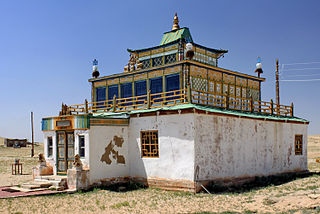
Khamar Monastery, founded in 1820, was an important Red Hat sect Buddhist monastic, cultural, and education center in Mongolia’s Gobi Desert region until its destruction in 1937. It was rebuilt in 1990. Today it is located in Khatanbulag district, Dornogovi Province, approximately 47 km south of the provincial capital Sainshand. At its height, the monastery reportedly accommodated over 80 temples and some 500 monks.
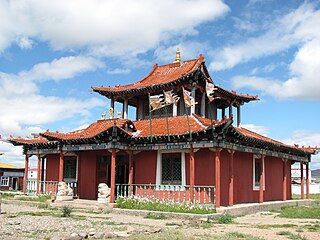
Gandandarjaalin Monastery is a small monastery built in the 1990s in Mörön, Khövsgöl Province to replace the original and much larger Mörön Monastery which was destroyed in 1937.